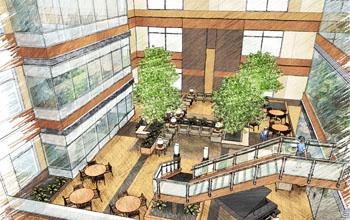
This artist’s rendering shows interior atrium space for the new Critical Care Tower under construction at Vanderbilt University Hospital. (courtesy Earl Swensson Associates Inc.)
New tower’s interior will be a family affair
Welcoming, adaptable, quality, world-class, peaceful, healing.
Those are just a few of the 18 guiding principles chosen to shape the interior design of the Critical Care Tower currently under construction at Vanderbilt University Hospital.
The focal point of the new tower will be the six-floor atrium, which strives to bring the outside world inside. There will be trees and a zen garden, and the materials will mimic things found in nature. There will be seating zones for different activities and a space for performances by Musicians on Call.
All other floors in the tower will have windows that look down on the atrium, and tiered skylights will flood the area with natural light.
Patient rooms will be divided into three zones for staff, patients and families.
This reflects the changing philosophy regarding the family's importance in patient care.
“We used to separate family members, but we realized family members can be the most important part of healing — a familiar voice at the bedside or someone to hold their hand. They also have an amazing bank of information that can make a difference in the patient's care,” said Terrell Smith, director of Patient and Family Centered Care.
The family zone has sleeper chairs that have been tested for comfort and durability, a full bath in every room, and a curtain that can be drawn for privacy.
The exterior of the tower blends the red brick of VUH with the sleek glass and steel of research buildings.
“We tried to get away from the all-brick look,” said Jim Tenpenny, architect and project manager. “We used brick on the lower levels that matches the existing towers, and blended this with the glass exterior to relate to other new buildings on campus.”
Charlotte Chaney, associate hospital director, says this blended design is the future look for all Medical Center exteriors.
The tower is on track for a November 2009 opening and the focus has turned to interior design, a process that was truly a collaborative effort.
The planning committee chose Earl Swensson Associates to assist, and at a listening session with staff and patients the guiding principles were established.
Members of the executive committee visited other medical facilities to observe their aesthetic, and a charge was led by Larry Goldberg, executive director and CEO of VUH, to envision the hospital of the future.
They also involved the Patient and Family Council in the decision-making process.
“Anxiety levels often increase for both patients and family members whenever they walk onto our campus,” said Mary Ann Brown Peugeot, chair of the Patient and Family Council.
“We want to make them feel comfortable and promote well-being in both the patient and their family.”
The Council found that patient input was crucial.
“I thought I had found the perfect chair, but we actually set up samples and diabetes patients said it cut off circulation at the calf. Without the input of real patients, we would have purchased 300 of the wrong chair,” Smith said.
They also took in staff considerations. Therapists have actually worked around the chairs, and nurses and Infection Control have decided where they want glove and needle boxes located.
Each floor will also have a quiet room for staff, featuring carpet and plush seating.
The ultimate goal is to create a design that will still be successful years later.
“We can't call it a success yet,” Tenpenny said. “Success is when we get down the road a few years and people say we did the right thing.”













